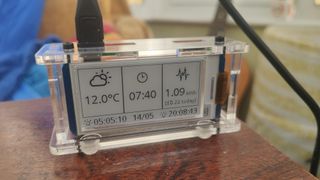
E-ink displays are a great way to reduce energy usage for your Raspberry Pi project. However, this creation, developed by maker Decrypt_Doctor over at Reddit, doubles up on that idea by using one to monitor a solar panel. So, in addition to keeping an eye on energy usage, it also functions as a clock and weather display.
This appears to be the first Raspberry Pi project submitted by Decrypt_Doctor, so we’re not sure what sort of history they have with the Pi, but it’s clear the project is backed by experience with software design and microelectronics. If you’re new to e-Ink displays, you may want to check out this e-Ink dashboard project to get an idea of what sort of tools you can implement with them.
In the Decrypt_Doctors project, a Raspberry Pi monitors the electricity supply box, checking for pulses generated by the solar generation meter. This data is stored in a database used to calculate exactly how much power has been generated by the panel to form an estimate of how much money has been saved. This estimation is displayed on the e-Ink display in real-time alongside the clock and weather data.
This project actually requires two Pis—an original Raspberry Pi model A monitors the solar panel system while a Raspberry Pi Zero W is used to power and update the e-Ink display. To keep things compact and simple, a Waveshare 2.13-inch e-Ink pHAT is used with the Pi Zero for the display output. These screens use less energy than an LCD display and complement the energy-saving nature of the project design.
According to Decrypt_Doctor, the e-Ink screen refreshes once every minute to update the weather, time, and solar panel data. The panel also includes extra details like expected sunrise and sunset times. To monitor the pulses from the solar panel generation meter, the model A uses an optical pulse sensor with an RJ45 breakout board.
Decrypt_Doctor also uses this project to estimate how much energy goes back into the power grid, which earns a little bit of extra money on the side. If you want to recreate this project yourself, or maybe develop something similar, check out the original thread shared on Reddit and be sure to follow Decrypt_Doctor for future updates.
Stay on the Cutting Edge
Join the experts who read Tom's Hardware for the inside track on enthusiast PC tech news — and have for over 25 years. We'll send breaking news and in-depth reviews of CPUs, GPUs, AI, maker hardware and more straight to your inbox.

Ash Hill is a Freelance News and Features Writer with a wealth of experience in the hobby electronics, 3D printing and PCs. She manages the Pi projects of the month and much of our daily Raspberry Pi reporting while also finding the best coupons and deals on all tech.
-
decrypt_doctor Thanks for featuring it - just to pick up one point, though. The monetary value displayed isn't savings, per se, it's income from the UK's feed-in-tariff system, through which micro-generation schemes get paid (a) a generation rate of about 15p / kWh for all the electricity they generate, and (b) a further export rate of about 5.5p. kWh for half of that, which they're deemed to export back to the grid to be used by their neighbours.Reply
Most Popular


